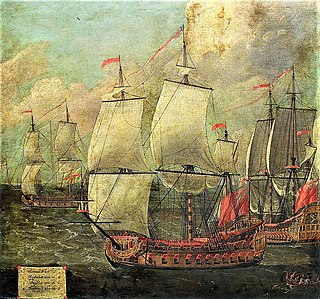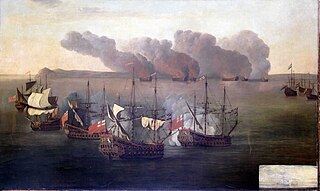
Sovereign of the Seas was a 17th-century warship of the English Navy. She was ordered as a 90-gun first-rate ship of the line, but at launch was armed with 102 bronze guns at the insistence of the king. She was later renamed Sovereign under the republican Commonwealth, and then HMS Royal Sovereign at the Restoration of Charles II.

HMS Cornwall was an 80-gun, third rate, ship of the line built for the Royal Navy in the 1690s. She served in the War of the Grand Alliance, and in her first year took part in the Battle of Barfleur and the action at La Hougue.

The Antelope was a ship of the English Tudor navy, launched in 1546. She was rebuilt three times, in 1558, 1581 and 1618. She thus served in various forms from the time of King Henry VIII to the English Civil War. She is mostly remembered for being a part of the fleet that defeated the Spanish Armada.
HMS Ruby was a 40-gun frigate of the Commonwealth of England, built by Peter Pett at Deptford. She took part in actions during all three of the Anglo-Dutch Wars of 1652–1654, 1665–1667 and 1672–1674. She later served in the West Indies, and in 1683 was sent to the Leeward Islands to protect British settlements against Caribbean pirate raids. In 1687, the English pirate Joseph Bannister was captured by the crew of Ruby and brought to Port Royal for trial. She was rebuilt in 1687. She was captured by the French in October 1707.
Nonsuch was a galleon of the English Navy. She was built on the orders of Queen Mary in 1555–56 as the Philip and Mary and renamed twice during her career — first to Nonpareil when she was rebuilt at Deptford in 1584, and later as Nonsuch when she was again rebuilt from 1603 to 1605.

Constant Warwick was originally a 32-gun privateer, built in 1645 as a private venture between the Earl of Warwick and Sir William Batten and intended to operate as a privateer. Hired for service in the Parliamentarian navy during the First English Civil War, her captain William Batten defected to the Royalists during the 1648 Second English Civil War. After her crew mutinied in November 1648, she returned to England and was purchased by Parliament for the Commonwealth Navy on 20 January 1649. Described as an "incomparable sailer", she was noted for her sharpness and fine lines, and is considered by some as the first true frigate of the Royal Navy. Mainly used for patrolling, she was captured by the French in 1691.

HMS Assurance was a 32-gun fourth-rate of the English Navy, built by Peter Pett I at Deptford Dockyard and launched in 1646. She was in the Parliamentary force during the English Civil War, then the Commonwealth Navy and was incorporated into the Royal Navy after the Restoration in 1660. During her time in the Commonwealth Navy she partook in the Battles of Dover, Portland, Gabbard and Texel. She foundered in a gale at Woolwich in 1660 and was salved. After the Restoration she partook in the Battle of Lowestoffe, the Four Days Fight and the Texel (1673). She was reduced to a Fifth Rate in 1690 before being sold in 1698.
Nonsuch was a 32-gun fourth-rate of the English Navy, built by Peter Pett I at Deptford Dockyard and launched in 1646. She was in the Parliamentary force during the English Civil War, then the Commonwealth Navy and was incorporated into the Royal Navy after the Restoration in 1660. During her time in the Commonwealth Navy she partook in the Battles of Krntish Knock, Portland and Gabbard. She was wrecked at Gibraltar on 3 December 1664.

Elizabeth was a 32/38-gun fourth rate vessel of the Kingdom of England, one of four new frigates ordered and built under the 1647 Programme. Her initial commission was in the Parliamentary Naval Force during the English Civil War. During the First Anglo-Dutch War, she missed all the major Fleet actions as much of the time she was in the Mediterranean. During the Second Anglo-Dutch War, she participated in the St James Day Fight. She was burnt by the Dutch off Virginia in March 1667.
Sapphire was a 38-gun fourth-rate of the Commonwealth of England. After commissioning she was actively involved in the First Anglo-Dutch War, participating in most major fleet actions. During the Second Anglo-Dutch War, she was only in the first two engagements then spent her time in Irish Waters and the Mediterranean. She was run ashore due to a pending attack by suspected Algerian pirates on Sicily in March 1670.
HMS President was a 34-gun fourth-rate of the English Navy, built by Peter Pett I at Deptford Dockyard and launched in 1650. She was incorporated into the Commonwealth Navy in 1650. She partook in the Battle off Dover and Kentish Knock in 1652, the Battle of Portland, the Gabbard and Scheveningen in 1653. She was renamed Bonaventure in 1660. After the Restoration she was incorporated into the Royal Navy. She was present at the Battle of Lowestoft (1665), the Four Days Battle and the Oxfordness in 1666. She was rebuilt in 1666. She was present at the Battle of Martinique in 1667, Battle of Solebay (1672), Battle of Schooneveld and Texel in 1673, the Battle of Beachy Head in 1690, the Battle of Barfleur 1692.
HMS Reserve was one of six 40-gun fourth-rate frigates, built for the Commonwealth of England under the 1650 Programme, after the Restoration of the monarchy in 1660 she was incorporated into the navy of the Kingdom of England. She partook in no major Fleet actions during the First Anglo-Dutch War. After the Restoration during the Second Anglo-Dutch War she partook in the Battle of Lowestoft, the Four Days' Battle and the St James Day Battle. She spent the bulk of her service either in the Mediterranean or at Newfoundland. She foundered off Yarmouth in November 1703.
The Pelican was one of six 40-gun fourth-rate frigates, built for the Commonwealth of England under the 1650 Programme. After commissioning she partook in the First Anglo-Dutch War being present at the Battles of Kentish Knock, Portland, the Gabbard and Scheveningen. She was accidentally burnt at Portsmouth in early 1656.

HMS Centurion was one of six 40-gun fourth-rate frigates, built for the Commonwealth of England under the 1650 Programme, she would be transferred to the navy of the Kingdom of England upon the Restoration of the monarchy in May 1660. When commissioned she partook in the First Anglo-Dutch War. After the first war ended she was in the Mediterranean fighting the Algerines at the Battle of Santa Cruz. She fought the battles of Dover, Portland, the Gabbard, and Scheveningen. During the Second Anglo-Dutch War she partook in the battles of Lowestoft and Orfordness. Following the second war she spent her time either in North America or the Mediterranean. She was wrecked in a storm in December 1689.
HMS Assistance was one of six 40-gun fourth-rate frigates, built for the Commonwealth of England under the 1650 Programme, after the Restoration of the monarchy in 1660 she was incorporated into the navy of the Kingdom of England. During her time in the Commonwealth Navy she partook in the First Anglo-Dutch War being present in the battles of Kentish Knock, Portland and The Gabbard. In the Mediterranean she was present at the Battle of Santa Cruz and the bombardment of Porto Farina, In the Second Anglo-Dutch War she was involved in the Battle of Lowestoft, Battle of Vagen and the St James Day Fight. She did not participate in fleet actions after this. She spent the rest of her service life undergoing several rebuilds and plying the waters as a cruiser protecting British trade and projecting British sovereignty. After nearly 95 years of Service she was sunk as a break water at Sheerness at the end of 1745.
Laurel was a 48-gun fourth-rate of the navy of the Commonwealth of England. She participated in almost all major Fleet Actions of the First Anglo-Dutch War. She was an active participant in the battles of Kentish Knock, Dungeness, Portland, The Gabbard and Scheveningen. She went to the west Indies with Admiral William Penn. She was wrecked in May 1657.

HMS Hampton Court was a 70-gun third rate ship of the line of the Royal Navy, launched at Deptford Dockyard in 1678. Her initial commission was to move her to Chatham where she spent in the next ten years in Ordinary. She held an active commission for the War of the English Succession, participating in the Battles of Beachy Head and Barfleur. She was rebuilt at Blackwall in 1699/1701. During the War of Spanish Succession she served mainly in the Mediterranean. In 1707 she was taken by the French and incorporated into the French Navy for four years. She was sold to the Spanish in 1712. She was wrecked in Spanish service off the coast of Florida in a hurricane in 1715.
HMS Deptford was a 50-gun fourth-rate ship of the line of the Royal Navy, launched at Woolwich Dockyard in 1687. This was the second of three 50-gun ships ordered in 1682/3.

HMS Lancaster was an 80-gun third rate ship of the line of the Royal Navy, launched at Bursledon on 3 April 1694.
Adventure was a 26-gun galley in the service of the English Navy Royal. She spent her early career in expeditions as far as West Indies, Cadiz and the Azores. She later was assigned to the Channel Guard during two more attempts by Philip II of Spain to invade England. She would spend the rest of her time in Home Waters, mainly the English Channel and North Sea. She was broken in 1645.







